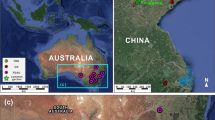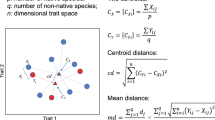Abstract
Why some alien species become invasive and some of their phylogenetically related congeners do not, is still an intriguing question in invasion biology. Hence, we compared 15 quantitative traits between 4 species of genus Potamogeton, of which 3 (P. crispus, P. nodosus and P. natans) are invasive and one (P. perfoliatus) is non-invasive. Regression analyses of the selected quantitative traits, excluding the leaf number, petiole and peduncle length, showed a significant variation amongst the haplotypes of invasive and non-invasive Potamogeton. The invasive species consistently showed a higher degree of performance-related traits than those of non-invasive species. Phenotypic differentiation among populations was moderate to high (PST = 0.10 to 1.00). Bray–Curtis cluster analysis obtained from 11 populations of the 4 species revealed the maximum trait similarity between P. perfoliatus of Nilnag lake with that of Manasbal lake (similarity indices 0.0796), as against the distantly related invasive P. crispus and non-invasive P. perfoliatus of Manasbal lake (similarity indices 0.7689). We also studied occurrence of target species in three lakes (Dal lake, Manasbal lake and Nilnag lake) of Kashmir Himalaya along a gradient of trophic status. In general, the highest trait values for all the studied species were recorded in eutrophic Dal lake systems, while the smallest values were found in the oligotrophic Nilnag lake. Conclusively, 12 out of 15 quantitative traits showed significant variation between invasive and non-invasive alien species of Potamogeton, thereby providing useful clues for invasiveness of the 3 species (P. crispus, P. nodosus and P. natans) in a typical eutrophic Dal lake. However, other two lakes are likely to be invaded in view of being in trophic evolution from mesotrophic to eutrophic.


Similar content being viewed by others
References
Baruch Z, Goldstein G (1999) Leaf construction cost, nutrient concentration, and net CO2 assimilation of native and invasive species in Hawaii. Oecologia 121:183–192
Bray JR, Curtis JT (1957) An ordination of upland forest communities of southern Wisconsin. Ecol Monogr 27:325–349
Callaway RM, Maron JL (2006) What have exotic plant invasions taught us over the past 20 years? Trends Ecol Evol 21(7):369–374
Charles H, Dukes JS (2008) Impacts of invasive species on ecosystem services. In: Nentwig W (ed), Biol invasions, pp 217–38
Cochard R, Jackes BR (2005) Seed ecology of the invasive tropical tree Parkinsonia aculeata. Plant Ecol 180:13–31
D’Antonio CM, Vitousek PM (1992) Biological invasions by exotic grasses, the grass/fire cycle, and global change. Annu Rev Ecol Syst 23:63–87
Daehler CC (2003) Performance comparasions of co-occuring native and invasive alian plants: implications for conservation and restoration. Annu Rev Ecol Syst 34:183–211
De Kroon H, Hutchings MJ (1995) Morphological plasticity in clonal plants: the foraging concept reconsidered. J Ecol 83:143–152
Dudgeon D, Arthington AH, Gessner MO, Kawabata ZI, Knowler DJ, Leveque C, Naiman RJ, Prieur-Richard AH, Soto D, Stiassny ML, Sullivan CA et al (2006) Freshwater biodiversity: Importance, threats, status and conservation challenges. Biol Rev 81:163–182
Ganie AH, Reshi Z, Wafai BA (2008) Multiple reproductive strategies contribute to invasiveness of Potamogeton crispus L. (Potamogetonaceae) in fresh ecosystems of Kashmir Hamalaya, India. In: Proceedings of Taal 2007: the 12th World lake conference, pp 1067–1073
Ganie AH, Reshi ZA, Wafai BA, Puijalon S (2014) Phenotypic plasticity: cause of the successful spread of the genus Potamogeton in the Kashmir Himalaya. Aquat Bot 120:283–289
Grotkopp E, Rejmánek M, Rostl TL (2002) Towards a causal explanation of plant invasiveness: seedling growth and life history strategies of 29 pine (Pinus) species. Am Nat 159:396–419
Grotkopp E, Rejmánek M, Sanderson MJ, Rostl TL (2004) Evolution of genome size in pines (Pinus) and its life-history correlates: supertree analyses. Evolution 58:1705–1729
Hulme PE (2003) Biological invasions: winning the science battles but losing the conservation war? Oryx 37:178–193
Hutchinson GE (1975) A Treatise on Limnology. Limnological Botany Vol. 3, John Wiley, New York
Kaplan Z (2002) Phenotypic plasticity in Potamogeton (Potamogetonaceae). Folia Geobotanica 37:141–170
Kawnsar-Ul-Yaqoob, Pandit AK, Wani SA (2008) Comparative physicochemical limnology of three lakes of Kashmir Himalaya. In: Proceedings of Taal 2007: the 12th world lake conference 1922–1927
Keser LH, Dawson W, Song Yao-Bin Yu, Fei-Hai FM, Dong M, van Kleunen M (2014) Invasive clonal plant species have a greater root-foraging plasticity than non-invasive ones. Oecologia 174:1055–1064. https://doi.org/10.1007/s00442-013-2829-y
Kettenring KM, Mock KE (2012) Genetic diversity, reproductive mode, and dispersal differ between the cryptic invader, Phragmites australis and its native conspecific. Biol Invasions 12:2489–2504
Kolar CS, Lodge DM (2001) Progress in invasion biology: predicting invaders. Trends Ecol Evol 16:199–204
Kolar CS, Lodge DM (2002) Ecological predictions and risk assessment for alien fishes in North America. Science 298:1233–1236
Legendre P, Legendre L (1998) Numerical ecology. Elsevier, Second English edition
Leuven RSEW, Boggero A, Bakker ES, Elgin AK, Verreycken H (2017) Invasive species in inland waters: from early detection to innovative management approaches. Aquat Invasions 12(3):269–273
Liebhold AM, Brockerhoff EG, Martin SK, Nũnez A, Wardle DA, Wingfield MJ (2017) Biological invasions in forest ecosystems. Biol Invasion 19:3437–3458
Liu J, Dong M, Miao SL, Li ZY, Song MH, Wang RQ et al (2006) Invasive alien plants in China: role of clonality and geographical origin. Biol Invasions 8:1461–1470. https://doi.org/10.1007/s10530-005-5838-x
Liu Y, Oduor AMO, Zhang Z, Manea A, Tooth IM, Xingliang XuM, van Kleunen M (2016) Do invasive alien plants benefit more from global environmental change than native plants? Global Chang Biol. https://doi.org/10.1111/gcb.13579
Lloret F, Médail F, Brundu G, Camarda I, Moragues E, Rita J, Lambdon P, Hulme PE (2005) Species attributes and invasion success by alien plants on Mediterranean islands. J Ecol 93:512–520. https://doi.org/10.1111/j.1365-2745.2005.00979.x
Meffin R, Miller AL, Hulme PE, Duncan RP (2010) Experimental introduction of the alien weed Hieracium lepidulum reveals no significant impact on montane plant communities in New Zealand. Divers Distrib 16:804–815
Merilä J (1997) Quantitative trait and allozyme divergence in the greenfinch (Carduelis chloris, Aves: Fringillidae). Biol J Linn Soc 61:243–266
Millennium Ecosystem Assessment (2005) Ecosystems and human wellbeing: wetlands and water synthesis. World Resources Institute, Washington, p 80
Milligan H, Deinet S, McRrae L, Freeman R (2014) Protecting species: status and trends of the earth’s protected areas. Zoological Society of London, UK
Mooney HA, Cleland EE (2005) The evolutionary impact of invasive species. Proc Natl Acad Sci 98:5446–5451
Montgomery DC (1991) Design and analysis of experiments, 3rd edn. Wiley, New York
Ogle SM, Reiners WA, Gerow KG (2003) Impacts of exotic annual brome grasses (Bromus spp.) on ecosystem properties of Northern mixed grass prairie. Am Midl Nat 149:46–58
Pejchar L, Mooney HA (2009) Invasive species, ecosystem services and human well-being. Trends Ecol Evol 24:497–504
Petruzzella A, Manschot J, van Leeuwen CHA, Grutters BMC, Bakker ES (2018) Mechanisms of invasion resistance of aquatic plant communities. Front Plant Sci 9:134. https://doi.org/10.3389/fpls.2018.00134
Pyšek P (1997) Clonality and plant invasions: can a trait make a difference. In: de Kroon H, Van Groenendael JM (eds) The ecology and evolution of clonal plants. Backhuys, Leiden, pp 405–427
Pyšek P, Richardson DM (2007) Traits associated with invasiveness in alian plants. J Biogeogr 33:2040–2050
Raeymaekers JAM, van Houdt JKJ, Larmuseau MHD, Geldof S, Volckaert FAM (2007) Divergent selection as revealed by PST and QTL-based FST in three-spined stickleback (Gasterosteus aculeatus) populations along a coastal-inland gradient. Mol Ecol 16:891–905
Reichard SH, Hamilton CW (1997) Predicting invasions of woody plants introduced into North America. Biol Conservation 11:193–203
Rejmanek M, Richardson DM, Pyšek P (2005) Plant invasions and invisibility of plant communities. In: Van der Maarel E (ed) Vegetation ecology, Oxford, Blackwell Publishing, pp 332–355
Schippers P, Olff H (2000) Biomass partitioning, architecture and turnover of six herbaceous species from habitats with different nutrient supply. Plant Ecol 149:219–231
Schlaepfer DR, Edwards P, Billeter R (2010) Why only tetraploid Solidago gigantean (Asteraceae) became invasive: a common garden comparison of ploidy levels. Oecologia 163:661–673
Shah AB, Reshi ZA, Shah MA (2014) Clonal trait diversity in relation to invasiveness of alien macrophytes in two Himalayan Ramsar sites. J Veg Sci 25:839–847
Speek TAA, Lotz LAP, Ozinga WA, Tamis WLM, Schaminée JHJ, Van der Putten WH (2011) Factors relating to regional and local success of exotic plant species in their new range. Divers Distrib 17:542–551. https://doi.org/10.1111/j.1472-4642.2011.00759.x
Spitze K (1993) Population structure in Daphnia obtusa –quantitative genetic and allozymic variation. Genetics 135:367–374
Sultan SE (2003) Phenotypic plasticity for fitness components in Polygonum species of contrasting ecological breadth. Ecology 82:328–343
Sultan SE (1987) Evolutionary implications of phenotypic plasticity in plants. Evol Biol 21:127–168
Van Kleunen M, Weber E, Fischer M (2010) A meta-analysis of trait differences between invasive and non-invasive plant species. Ecol Lett 13:235–245
Vilà M, Espinar JL, Hejda M, Hulme PE, Jarošík V, Maron JL, Pergl J, Schaffner U, Sun Y, Pyšek P (2011) Ecological impacts of invasive alien plants: a meta-analysis of their effects on species, communities and ecosystems. Ecol Lett 14:702–708
Vorosmarty CJ, McIntyre PB, Gessner MO, Dudgeon D, Prusevich A, Green P, Glidden S, Bunn SE, Sullivan CA, Liermann CR, Davies PM (2010) Global threats to human water security and river biodiversity. Nature 467:555–561. https://doi.org/10.1038/nature09440
Wang YJ, Müller-Schärer H, van Kleunen M, Ai-Ming C, Zhang P, Yan R, Dong B-C, Yu F-H (2017) Invasive alien plants benefit more from clonal integration in heterogeneous environments than natives. New Phytol. https://doi.org/10.1111/nph.14820
Wani GA, Shah MA, Reshi ZA, Dar MA (2018) Polyploidy determines the stage of invasion; clues from Kashmir Himalayan aquatic flora. Acta Physiol Plant. https://doi.org/10.1007/s11738-018-2629-4
Wiegleb G, Kaplan Z (1998) An account of the species of Potamogeton (Potamogetonanaceae). Folia Geobot 33:241–316
Williamson F, Fitter A (1996) The characters of successful invaders. Biol Conserv 78:163–170
Zedler JB, Kercher SM (2004) Causes and consequences of invasive plants in Wetlands: opportunities, opportunists, and outcomes. Crit Rev Plant Sci 23:431–452
Zhang XL, Gituro RW, Yang CF, Guo YH (2009) Variation of floral traits among different life forms illustrate the evolution of pollination system in Potamogeton from China. Aquat Bot 90:124–128
Acknowledgements
Financial support by the DBT through its Indo-Canadian project to MAS is duly acknowledged. The financial support by DST-SERB, Govt. of India under the National Post-Doctoral Fellowship (PDF/20l8/001689) to GAW is also acknowledged. This article was supported by Department of Biotechnology, Govt of India (Grant DBT-IC-IMPACT/MAS/30/2015-16).
Author information
Authors and Affiliations
Corresponding author
Ethics declarations
Conflict of interest
The authors declare that they have no conflict of interest.
Additional information
Communicated by R. Baczek-Kwinta.
Publisher's Note
Springer Nature remains neutral with regard to jurisdictional claims in published maps and institutional affiliations.
Rights and permissions
About this article
Cite this article
Wani, G.A., Reshi, Z.A., Khasa, D.P. et al. Phenotypic trait variation in invasive and non-invasive alien species of Potamogeton in Kashmir Himalayan lakes of varying trophic status. Acta Physiol Plant 42, 73 (2020). https://doi.org/10.1007/s11738-020-03062-8
Received:
Revised:
Accepted:
Published:
DOI: https://doi.org/10.1007/s11738-020-03062-8




